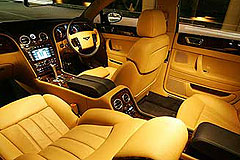First drive: Bentley's $375K Flying Spur wafts in
BY TIM BRITTEN | 17th Jun 2005

For one, it's one of the few car-makers to be expanding its business. For seconds, it's not just a successful brand - it's also a successful British brand.
Take the Australian market, where the Continental Flying Spur has just joined the GT coupe on sale, for example.
In 2004, Bentley sold no less than 130 cars in Australia, a considerable increase over its 2003 figure of just 31 cars. Sales comprised mostly the new Continental GT coupe (113), with 17 buyers taking delivery of the high-price Arnage saloon.
But the important fact is that the average price for a Bentley was something like $400,000 per car, making the turnover in 2004 something in excess of $50 million.
As an upper-echelon luxury carmaker, Bentley appears to have it made.
And even more so now that the Continental Flying Spur saloon, which was developed at the same time as the GT coupe, has been launched in Australia.
The Flying Spur has the same basic chassis and mechanicals as the GT, but stretches the wheelbase by 300mm to allow for a long-wheelbase Mercedes-Benz S-class size body and recalibrates the air suspension to provide a plusher - yet still sporting in the Bentley tradition - on-road experience.
On its 3065mm wheelbase, which is a tad under long-wheelbase Mercedes-Benz S-class and BMW 7 Series models, sits a 5.3-metre body resplendent in every luxury you'd imagine in a car that retails for $375,000 and takes over more or less where the German brands leave off (Bentley has its share of Teutonic origins too, as Volkswagen is the parent company).
It sits below where BMW (Rolls-Royce) and Mercedes-Benz (Maybach) locate their upper-echelon vehicles and that appears to be proving a good judgement on VW's part, because neither BMW nor Mercedes can claim sales that meet initial expectations.
Thr Flying Spur is priced in the same region as the Continental GT, which means it is less than the Arnage but still clearly a car for the privileged few.
It is as impressive for its size, weight and performance capabilities as it is for its sheer luxury.
Power is supplied by a reworked version of the "W12" powerplant developed by VW that can be traced back to the narrow-angle V6 used in VW and Audi models.
In Bentley form (the base block is shipped to the factory at Crewe in the UK to be built up to the required specs) the 6.0-litre engine produces 411kW and 650Nm via twin turbochargers.
This is enough to propel the Flying Spur's 2475kg to 100km/h in 5.2 seconds and push the aerodynamic body (Cd is a surprisingly efficient 0.31) to an unrestricted top speed of 312km/h.
Handling all this power and utilising Volkswagen driveline expertise, the Flying Spur, like the GT, uses constant all-wheel drive to make sure the power is delivered effectively to the road.

The rest of the car, a bit like the Rolls-Royce Phantom, is larger than life, with front disc rotors that are reputed to be the largest used in any passenger car, all modern electronic aids including electronic stability control and traction control, and an interior that just about exceeds the imagination in terms of indulgences.
Where the Bentley is unlike the Rolls-Royce is in its understated presence, which contrasts with the blatant extravagance of the million-dollar, BMW developed Phantom.
The Bentley's interior lacks nothing, except, strangely, a sunroof that can be ordered as an option.
The Flying Spur will seat five in excessive luxury or, if you want, just four.
In the latter case a pair of individual rear seats cosset passengers in supreme comfort with the same levels of adjustability as the front seats, as well as individual air-conditioning controls - which means there is a total of four almost-discrete climate zones throughout the cabin.
Appropriately, the Flying Spur has a big, cleanly-shaped boot comfortably able to accommodate expensive luggage.
With 130 sales recorded in 2004, Bentley expects to record similar numbers in 2005 as the market for GTs tapers slightly and the Flying Spur steps in.
Long-term, annual Australian sales of around 80 to 100 vehicles a year is seen as a realistic expectation of a brand that at the moment has a waiting list up to eight months and is producing around 6500 vehicles per annum with its 65-acre Crewe plant running on double shifts.
It's too early to see any definite trends in buyer profiles, but the average age of Australian owners is surprisingly young, in the early 40s. One New Zealand buyer was just 21 when he bought his new Arnage.
Not surprising is the fact that a high percentage of Bentley owners in Australia are new to the brand and that too few cars are coming onto the used market to determine residual values. In most cases where a GT has come up for resale, the price paid has been virtually equivalent to the new, list price.
And people are using them too. Some Bentley customers have racked up as much as 30,000km in 12 months of ownership.